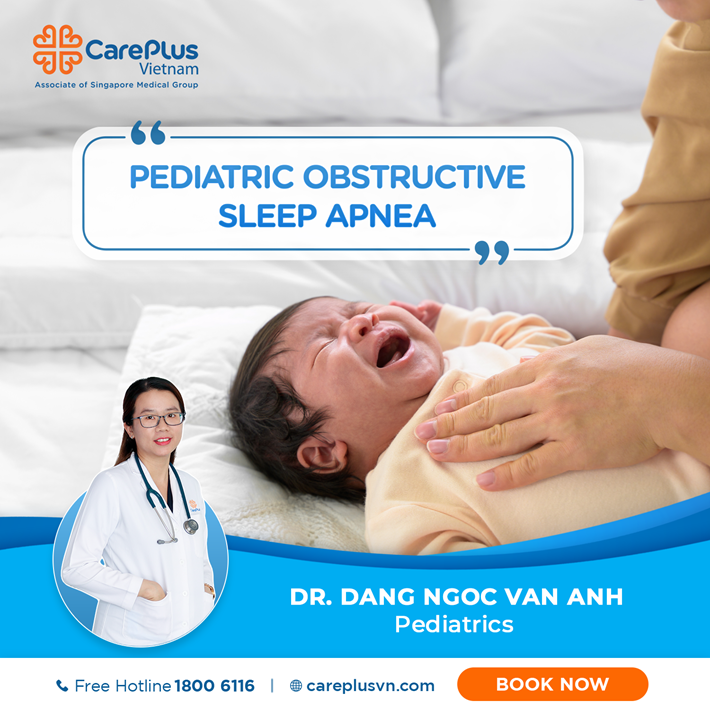Obstructive Sleep Apnea - What it is and how it can be treated?
Obstructive Sleep Apnea (OSA) is when a child stop breathing briefly while sleeping due to the throat narrowing or closing. Among them, "obstructive sleep apnea" (OSA: Obstructive Sleep Apnea) is the most common in 2-5% of children and can occur at all ages, including adults, most commonly in children in their teens. Age 2-6 years old.

2/22/2024 2:31:56 PM
What is Obstructive Sleep Apnea?
Obstructive Sleep Apnea (OSA) is when a child stop breathing briefly while sleeping due to the throat narrowing or closing. Among them, "obstructive sleep apnea" (OSA: Obstructive Sleep Apnea) is the most common in 2-5% of children and can occur at all ages, including adults, most commonly in children in their teens. Age 2-6 years old.
This condition often occurs in children when the tonsils or adenoids are more significant than usual. These are soft tissue areas at the back of the mouth, throat, and nose that, when swollen, will prevent the child from breathing normally through the mouth or nose.
Risk factors
Tonsillar hypertrophy and obesity are major risk factors for OSA in healthy children.
-
Obesity is a significant risk factor for OSA in all ages but is especially prominent in adolescents. In a prospective study, OSA was diagnosed in 4% of adolescents (16 to 19 years old), and most of them had snored as children.
-
Other risk factors for medical, neurological, skeletal, or dental conditions that reduce the size of the upper airway, affect the neurological control of the upper airway, or affect the ability to Collapse of the upper airway are also risk factors for OSA. Babies who develop OSA at an early age are especially likely to have anatomical or genetic defects:
Cerebral palsy
-
Down syndrome, Prader-Willi syndrome
-
Craniofacial abnormalities
-
Orthodontic problems
-
OSA family history
-
History of premature birth and multiple pregnancy, history of low birth weight.
Symptoms and Signs of Obstructive Sleep Apnea (OSA)
Sleep apnea causes symptoms both at night and during the day. At night, your baby can:
● Snoring, loud breathing, or difficulty breathing
● There are pauses between breaths or sudden gasps for air
● Breathe through your mouth
● Seems restless or moves around a lot
● Sweating a lot
● Bedwetting or waking up frequently to urinate.
During the day, your baby can:
● Waking up with a headache
● Feeling very tired
● Drowsiness at unusual times, such as at school or on short car rides
● Breathe through your mouth
● Have difficulty concentrating in school
● Appear grumpy or irritable.
When to see a doctor
If you think your child may have sleep apnea, see your pediatrician. The doctor will examine your baby's symptoms and sleeping habits. The doctor will likely examine your baby's mouth and throat, checking to see if the tonsils and adenoids are enlarged.
The doctor may also recommend taking your child to see another specialist. This could be a specialist in sleep problems or an ENT doctor.
Treatment
There are two main treatments for sleep apnea in children:
-
Surgery to remove tonsils or adenoids: If your baby's tonsils or adenoids are more significant than usual, sleep apnea is often treated with surgery to remove them.
-
Continuous positive airway pressure (CPAP) – This method may be recommended if the baby's tonsils and adenoids are of average size, surgery is not a treatment option, or surgery does not relieve symptoms. There are times when doctors recommend CPAP treatment several weeks before a tonsillectomy.
-
Your baby will wear a mask over his nose while sleeping for CPAP treatment. The mask connects to the machine to help air circulate and clear the baby's airways.
-
Some children also need other treatments. For example, children with a narrow palate (roof of mouth) may need to see an orthodontist. Sometimes, it is helpful to have a device that can open up the roof of your mouth and help you breathe easier while you sleep.
The doctor may recommend medication for children with seasonal allergies (allergic rhinitis) to help relieve nasal congestion.
Can parents do anything to help their children with Obstructive Sleep Apnea?
In addition to the above treatments, several other methods may be helpful. Parents can:
-
Don't smoke indoors because secondhand smoke can make sleep apnea symptoms worse.
-
Help your child lose weight if they are overweight
-
Avoid letting your child sleep on their back. You can use a pillow to raise the child's head while sleeping or adjust the head of the bed higher when the baby sleeps, which also helps support treatment.
Consequences of OSA if left untreated:
-
Behavioral problems and inattention (e.g., hyperactivity, impulsivity, rebelliousness, and aggression).
-
Sleep during the day.
-
Growth effects: Severe OSA may be associated with growth retardation, and treatment may help regain weight and support growth.
-
Cardiovascular disease: Over time, sleep apnea can lead to heart problems. These may include a faster-than-normal heart rate or high blood pressure.
Untreated sleep apnea in children is associated with behavioral and learning problems. In more severe cases, it may be associated with impaired growth (including developmental delay) and cardiovascular complications. Early diagnosis and treatment can reduce the incidence of the disease.
Make an appointment via hotline 18006116 or inbox the CarePlus Clinic Vietnam page for advice.